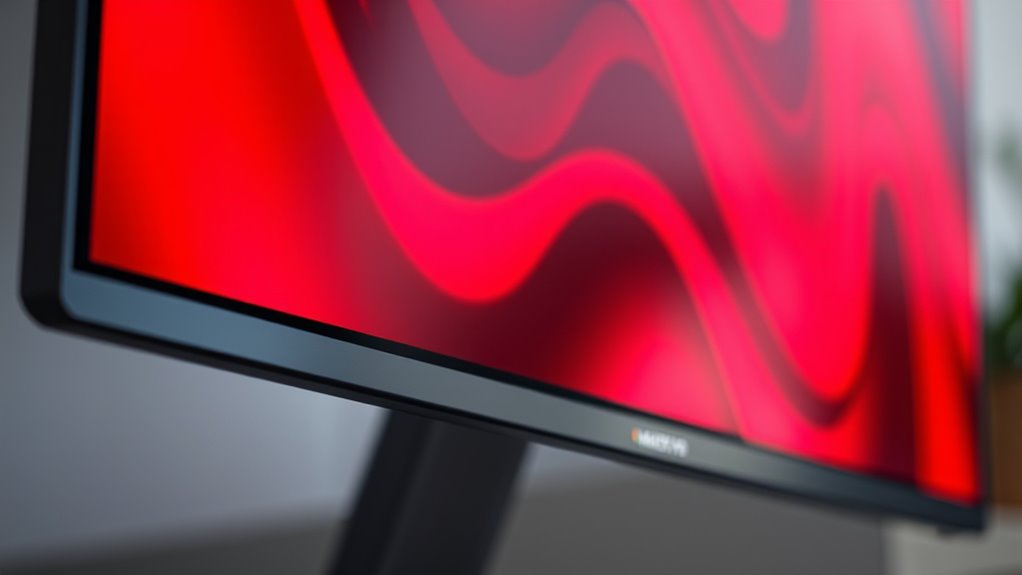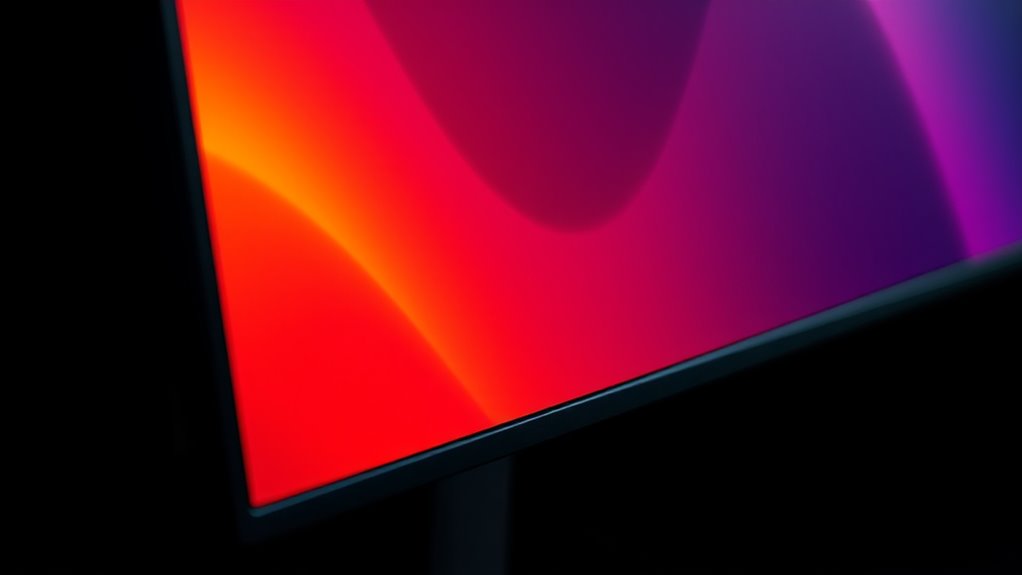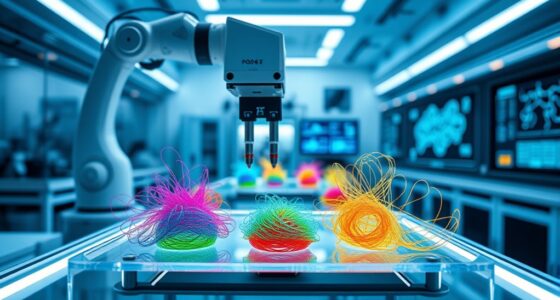OLED monitors stand out because each pixel emits its own light, resulting in stunning contrast, perfect blacks, and vibrant colors that pop with clarity. They offer wide viewing angles, quick response times, and flexible design options like curved or ultra-thin profiles. While they may have some longevity concerns, their exceptional image quality, energy efficiency, and sleek style make them a smart choice. To discover how these features can elevate your experience, keep exploring what makes OLED monitors special.
Key Takeaways
- Self-emissive pixels enable perfect blacks and high contrast ratios, resulting in vibrant, lifelike images.
- Wide viewing angles maintain consistent color and contrast from nearly any position.
- Superior color accuracy and broad color gamut deliver richer, more accurate visuals.
- Faster response times and reduced motion blur enhance gaming and fast-paced content experiences.
- Energy efficiency improves with darker scenes, lowering power consumption and heat generation.
Understanding OLED Display Technology

Understanding OLED display technology begins with recognizing that OLEDs are made of organic materials that emit light directly when electrically stimulated. These devices consist of multiple layers: a substrate, an anode, a cathode, a conductive layer, and an emissive layer. The organic semiconductor materials in OLEDs have conductivity properties ranging from insulators to conductors, thanks to conjugated molecular structures. Multilayer designs improve efficiency by enhancing charge injection and balancing electron-hole recombination within the emissive layer. When you power on an OLED, light results from organic molecules in the emissive layer, where electrons and holes recombine. This direct emission eliminates the need for a backlight, making OLEDs thinner, more flexible, and capable of producing vibrant images with high precision.
Unmatched Image Quality and Contrast Levels

You’ll notice that OLED monitors deliver truly deep blacks and incredible contrast, thanks to their ability to turn off individual pixels completely. This results in images with striking depth and realistic detail, even in dark scenes. Coupled with vivid, true-to-life colors, OLEDs create an immersive viewing experience that’s hard to match. Additionally, their superior contrast ratio significantly enhances overall image quality, making every scene appear more vibrant and lifelike. The self-emitting pixel technology ensures that each pixel independently produces light, contributing to the stunning contrast and color accuracy. Moreover, OLED displays are renowned for their wide viewing angles, allowing consistent picture quality from various positions. This advanced display technology also reduces motion blur, providing smoother visuals during fast-paced action. Because each pixel operates independently, OLED screens are also less prone to image retention, ensuring sustained clarity over time.
True Blacks and Contrast
OLED monitors deliver unparalleled contrast and true blacks because their self-emissive pixels can turn off completely, creating perfect black levels that LCDs struggle to match. This ability results in an almost infinite contrast ratio, especially in dark environments, enhancing HDR content by deepening blacks and boosting dynamic range. Unlike LCDs, which rely on backlights that can produce light bleed and glow, OLED pixels emit light only when needed, avoiding unwanted illumination in black areas. However, ambient light can reduce perceived black depth, making blacks appear less deep, especially in bright rooms. WOLED panels generally maintain better black levels under ambient conditions than QD-OLEDs. Coatings also matter—matte finishes help preserve black depth by reducing reflections, ensuring contrast remains sharp and image quality high. Additionally, the luminous efficiency of OLED pixels contributes to their superior performance in displaying true blacks with minimal power consumption.
Vivid Color Reproduction
Have you ever noticed how vibrant and true-to-life OLED monitors look? That’s because they use organic compounds that emit light directly, ensuring high color accuracy. Each pixel divides into sub-pixels for red, green, and blue, which helps deliver precise colors with minimal overlap. Advanced algorithms dynamically manage sub-pixel brightness, maintaining color fidelity in real-time. Since OLEDs are self-emissive, they produce their own light, eliminating backlight issues and enhancing contrast. The wide color gamut allows for rich, vivid hues, making images pop. Plus, improved color purity from technologies like LG’s RGB Tandem structure boosts brightness and clarity. With superior viewing angles and minimal color distortion, OLED monitors deliver unmatched image quality—making your visuals more immersive and true-to-life. Additionally, diverse design options contribute to their appeal, allowing for sleek and customizable setups that complement any workspace or entertainment area.
Superior Viewing Angles and Innovative Design Options

Thanks to their self-emissive pixels, OLED monitors deliver superior viewing angles that keep images vibrant and consistent even when viewed from the side. You can enjoy up to 178 degrees horizontally and vertically without noticeable color shifting or brightness loss. Unlike LCD panels, OLED maintains true blacks and contrast at sharp angles, making multi-viewer setups seamless. While some minor color tinting may occur at extreme off-center views, overall, OLEDs ensure consistent image quality across wide angles. Their design flexibility allows for ultra-thin, curved, and minimalist profiles, giving your workspace a sleek, modern look. Plus, features like adjustable stands and curved screens enhance comfort during long use, combining aesthetic appeal with ergonomic benefits. Additionally, pollution and hydrogen fuel cells highlight how innovative technologies can promote sustainability and environmental benefits, similar to the eco-friendly advantages of OLED displays. The adaptability of OLED technology also supports artistic innovation, enabling designers to craft new form factors and immersive visual experiences. Moreover, advancements in quality assurance practices ensure that OLED monitors meet high standards of reliability and performance, making them a valuable investment. Furthermore, ongoing research into manufacturing processes continues to improve the durability and lifespan of OLED panels, reinforcing their long-term value.
Enhanced Performance for Gaming and Creative Work

Building on their superior viewing angles and sleek design options, OLED monitors excel in delivering lightning-fast response times and minimal input lag, making them ideal for gaming and creative tasks. With response times around 0.03 ms, motion blur and ghosting are markedly reduced, giving you crisp visuals during fast-paced gameplay. Input lag can be as low as 22 ms, ensuring quick reactions in competitive scenarios, especially with refresh rates up to 240 Hz or even 480 Hz at 1080p. These monitors also offer exceptional contrast with true blacks and vibrant HDR highlights, enhancing immersion in both games and video editing. Their high resolution and wide color gamut support detailed visuals and color accuracy, making them perfect tools for creative professionals seeking precision and responsiveness. Additionally, understanding personal finance management can help users make informed decisions about investing in high-end technology like OLED monitors. For instance, their cost often reflects advanced display technology, so evaluating your needs and budget is essential before purchasing. Moreover, staying aware of cybersecurity threats can help protect your investment and digital data when using high-end devices, especially as such technology becomes more integrated with online services. Considering energy efficiency is also important, as some OLED monitors incorporate features that reduce power consumption without sacrificing performance.
Energy Savings and Power Efficiency Benefits

OLED monitors adjust their power consumption based on what’s displayed, saving energy when showing darker scenes or UI themes. Because each pixel turns off individually, they use less power and generate less heat compared to other displays. This dynamic power usage makes OLED monitors more efficient, especially during tasks with varying brightness levels.
Dynamic Power Usage
Because OLED monitors only consume power in the pixels that emit light, their energy usage varies considerably depending on the displayed content. Dark scenes with black pixels draw almost no power, while bright images activate more pixels and increase consumption. Many models include features like brightness capping, pixel shifting, and adaptive brightness to manage power dynamically. These tools help reduce energy use during static images or low-brightness content and optimize power based on ambient lighting. In gaming or media with dark themes, OLEDs save more energy compared to LCDs, which rely on constant backlight. This dynamic power management not only conserves energy but also extends panel lifespan and reduces heat, making OLED monitors both efficient and environmentally friendly. Additionally, understanding Volkswagen Tuning principles can be akin to optimizing display settings for performance and longevity, emphasizing the importance of managing resources effectively, especially considering the power efficiency benefits of OLED technology. Furthermore, advances in energy-saving features continue to enhance the sustainability of OLED displays for everyday use. Incorporating power management strategies can further improve overall device longevity and reduce environmental impact.
Reduced Heat Generation
As OLED monitors dynamically adjust power based on displayed content, they generate less heat when showing darker images. This efficiency reduces energy waste and helps keep the display cooler. Lower heat output means less strain on the organic materials, which slows chemical degradation and extends lifespan. Plus, less heat reduces the need for active cooling solutions, cutting down on noise and maintenance. Additionally, ongoing research into AI safety measures aims to develop more robust safety protocols for future display technologies. Incorporating user safety features in design can further enhance reliability and user confidence. Recognizing the importance of industry standards can ensure these advancements meet safety and quality benchmarks.
Addressing Limitations and Longevity Challenges

While OLED monitors deliver exceptional contrast and deep blacks, they face significant challenges related to brightness degradation and limited lifespan. Over time, individual pixels gradually lose brightness, especially blue pixels, leading to color imbalance and reduced accuracy. This degradation makes OLEDs less bright than traditional LCD or mini-LED screens, particularly with full-screen content. Additionally, prolonged use and static images can cause burn-in, further impacting longevity. The organic materials in OLEDs also limit their overall lifespan, with blue components wearing out faster than red or green. Environmental factors like humidity and heat accelerate deterioration. To extend your monitor’s life, avoid static images, keep brightness at moderate levels, and follow recommended maintenance routines. Despite these hurdles, OLEDs still offer unmatched contrast and HDR performance. Ongoing advancements in AI chip development are contributing to smarter display management that could mitigate some longevity issues in future OLED technologies. Moreover, implementing screen savers and periodic rest periods can help preserve display quality over time.
Why OLED Monitors Are a Smart Investment

OLED monitors stand out as a smart investment due to their exceptional visual quality and immersive experience. They deliver deeper blacks, true contrast ratios, and more vibrant colors, making images pop with precision. Thanks to their wider viewing angles, you see consistent color and brightness from nearly any perspective. Faster pixel response times reduce motion blur, perfect for gaming and high-motion content. Additionally, OLEDs are energy-efficient, especially when displaying dark scenes, lowering operational costs over time. Their flexible, lightweight design allows for sleek, modern setups, and their durability across a broad temperature range makes them suitable for various environments.
OLED monitors offer stunning contrast, vibrant colors, and energy efficiency for immersive, versatile setups.
Consider these benefits:
- Stunning contrast and vivid colors for professional and entertainment use
- Reduced energy consumption, saving money long-term
- Durable, flexible design for diverse applications
Frequently Asked Questions
How Long Do OLED Monitors Typically Last Before Image Degradation Occurs?
You might wonder how long OLED monitors last before image degradation. Typically, they last between 20,000 and 100,000 hours, depending on usage. Factors like static images, brightness, and environmental conditions can shorten their lifespan. To maximize longevity, you should use screen savers, avoid high brightness, and prevent static content. Recent tech improvements have extended OLED durability, making them a reliable choice for long-term use.
What Measures Are Manufacturers Taking to Prevent OLED Burn-In Issues?
Think of your OLED monitor like a delicate garden that needs tending. Manufacturers equip it with tools like pixel refresh and panel maintenance to prevent burn-in, much like watering and pruning. They also include brightness adjustments, auto-brightness, and advanced technologies to distribute pixel usage evenly. By following recommended habits—like avoiding static images and using screen savers—you help keep your display vibrant and healthy for years to come.
Are OLED Monitors Suitable for Long-Term Static UI Display Tasks?
You might wonder if OLED monitors are suitable for long-term static UI tasks. They can be, if you follow best practices like using dark themes, enabling pixel shifting, and avoiding high brightness. Turning off the monitor when not in use and limiting static content exposure also helps. While burn-in risk exists, newer OLED tech and careful usage make them a viable option for sustained static UI display, with manageable long-term effects.
How Does the Cost of OLED Monitors Compare to Traditional LCDS?
You’ll find OLED monitors usually cost several hundred dollars more than comparable LCDs, with prices often around £1,200 to £1,400. This higher price reflects their complex manufacturing process and organic materials, which are more expensive. While OLEDs offer better contrast and color, the initial investment is significant. However, advances are lowering costs, and their energy efficiency and superior display quality can make the extra expense worthwhile over time.
Can OLED Monitors Be Repaired if Pixels Become Damaged or Degraded?
If your OLED monitor’s pixels get damaged or degrade, repairing them isn’t straightforward. You can try tools like JScreenFix or gentle methods like pressure or tapping, but these carry risks and often aren’t very effective. For serious issues, your best bet is professional repair or replacement, since OLED screens are delicate and repairs can void warranties. Ultimately, prevention and cautious handling are key to avoiding pixel problems altogether.
Conclusion
So, while OLED monitors might seem like a luxury you don’t need, their stunning image quality and sleek design prove otherwise. Sure, they have some quirks and longevity concerns, but who cares? After all, a little burn-in is a small price to pay for visuals that make every other screen look dull. Go ahead, indulge—your eyes and your workspace deserve the best, even if it’s a bit more “high-maintenance.”









